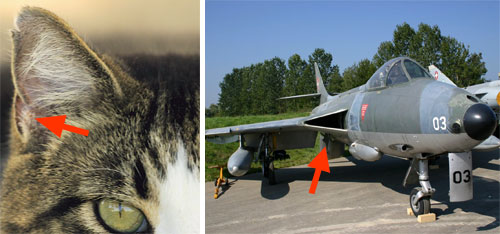You may have heard of the Aquatic Ape theory, which deduces from our hairless skin that our ancestors had gone through an ocean-dwelling phase. Well — here is my new theory: that the common cat, Felis catus, evolved from a flying creature!
Consider the cat’s ear. Whenever I scratch a cat behind the ears I can’t help but notice the way the external ear is split near its base, forming a narrow hollow. This seemingly useless feature always reminds me of the wing root air intake seen on some jet fighters, like the Hawker Hunter seen in the photo.

So why would the cat have this vestigial structure? Obviously, because in some earlier part of its evolution it was a flying creature, using flight to catch small birds in midair, which remain a favorite source of food with modern cats as well. Then some proto-cat discovered that it’s far easier to charm the evolving human race into feeding it, and the wings were lost over the generations, becoming the ears we see today.
Oh well, not really…






Nathan,
I can see how the vestigial air intake caused you to think that the cat had a jet engine. But when you scratch its ear you can hear the vestigial internal combustion engine…
True. True.
The kitty’s name is Baby. She is my mom’s cat. I photographed her often because she seemed to like it. She couldn’t fly though.
Give Baby my regards, Michael!